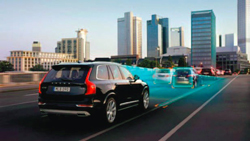|
 Low-Cost Lidar—AEB systems utilize on-vehicle sensors, generally including LiDAR (light detection and ranging), to help detect and identify an imminent crash with a vehicle up ahead. The cost of a LiDAR sensor is expected to eventually come down, well under US$100. "One low-cost LiDAR under development utilizes a pulsed laser along with a two-by-eight array of 16 photodiodes, and it has a detection range of 30 m," says Rajeev Thakur, a marketing manager for Osram Opto Semiconductors, Munich, Germany. The photodiode array is wider than it is high because horizontal resolution is what matters most for the intended application, AEB systems. Low-Cost Lidar—AEB systems utilize on-vehicle sensors, generally including LiDAR (light detection and ranging), to help detect and identify an imminent crash with a vehicle up ahead. The cost of a LiDAR sensor is expected to eventually come down, well under US$100. "One low-cost LiDAR under development utilizes a pulsed laser along with a two-by-eight array of 16 photodiodes, and it has a detection range of 30 m," says Rajeev Thakur, a marketing manager for Osram Opto Semiconductors, Munich, Germany. The photodiode array is wider than it is high because horizontal resolution is what matters most for the intended application, AEB systems.
Osram makes the LiDAR laser and photodiode components composed of ultrafast-response indium–gallium–arsenide semiconductors. Its partner, the start-up company Phantom Intelligence, Quebec, Canada, integrates Osram’s components into the LiDAR’s electronics module, which has a footprint about the size of a business card. The full sensor package is larger, but it is claimed that it can fit on the inside of the windshield, just ahead of the rear-view mirror.
The LiDAR sensor neither scans mechanically, like a roof-mounted one, nor electronically. Instead, it emits near-infrared (IR) light from a dedicated IR-pulsed laser diode. The 16 photodiodes detect pulses reflected in two vertical planes, with each plane segmented into eight horizontally-spaced IR-photodiode detection channels. The received IR pulses are digitally processed to compute the distance and the rate of change in distance as detected in each of the 16 channels. The photodiodes are especially suitable for automotive LiDAR applications for their given fast switching time.
Read the full article: IEEE Vehicular Technology
Magazine, Volume 11, Issue 1, March 2016 |